The role of an account manager has evolved and changed significantly over the last few years. Particularly with the growth of customer success, SaaS account management has seen their goals and tasks become more streamlined and high level, leaning closer to sales and farther from customer service.
In today’s guide, let’s explore the role of SaaS account management today. Here’s a summary of what you can expect:
- I’ll start with a review of the basics: what SaaS account management means, when it’s beneficial to your company, and the common functions it serves.
- Then it’s time to see the responsibilities of SaaS account management – what their key goals are, and how do those contrast with other teams like customer success.
- After that, we’ll review best practices for efficient SaaS account management, with concrete advice and examples.
- Then we’ll move onto common challenges, mistakes, and misconceptions about account management and attempt to clear them up.
- I’ll end by answering some FAQs people have about account management.
What Is SaaS Account Management?
SaaS Account Management is the process and company function tasked with keeping an overview of business accounts, maintaining customer workflows and relationships, and assisting, renewing, and expanding those accounts. They also own accounts from the presale stage to the expansion stage of the customer lifecycle, with a focus on commercial outcomes and reactive practices for customer engagement.
The most important distinction between account management and customer success is that the former operates on a contract level. They may assist customer success on ground level and time-sensitive requests, and they may conduct some EBRs or QBRs, but on the whole account managers care more about the big picture than about day-to-day customer service.
Why Is Account Management Important? Benefits of an Account Management Strategy
Depending on the size of your organization, SaaS account management may be a smaller function, and may even mix with customer success. However, once you’re past your initial SaaS stages, you’ll start to see why those two roles should be separate.
Here are the benefits of a comprehensive SaaS account management strategy:
- Scalable Growth. Lets you manage a great number of accounts over multiple products and subscription tiers in a more efficient way.
- Churn Reduction. Allows account managers, CSMs, and customer support to work together and strategically reduce churn and support company-wide retention goals.
- Technical Support. Can provide better account-level assistance for technical products when it comes to implementation, custom development needs, and specific support requests.
- Complexity Control and Mitigation. Complements companies with a complex business model, allowing for better alignment on customer outcomes and goals across the organization.
- Streamlines Operations. Can enable a lean business model, making it more efficient to operate in distinct industries and with different types of customers.
- Commercial Focus. Oversees customer lifetime value, acquisition costs, and attempts to shorten payback periods through retention and expansion tactics. Attempts to boost revenue (NRR, MRR, GRR).
SaaS Account Management Team Members
Here are the typical roles seen within a SaaS account management team:
- Account Managers. The core of the team will be Account Managers, an entry level position that serves as the point of contact between a company and its clients.
- Technical Account Managers. TAMs are less focused on high-level account demands and more into the concrete technical aspects of customer enablement, helping with implementation, development, and issue resolution.
- Strategic Account Managers. SAMs are essential for businesses with large, enterprise customers. That’s because they typically handle only the most important clients, even if that sometimes means overseeing a single account.
- Head of Customer Success. In many organizations, account managers are part of CS, and thus managed by the leader of the customer success department.
- VP of Sales. In other companies, account managers are part of Sales, and therefore managed by the head of the Sales department.
How Does Account Management Work?
Fundamentally, account management works by providing consistent, impactful value to customers. Throughout their efforts, account managers aim to become a pillar clients can rely on for their goals, issues, suggestions, and feedback. A Gallup study confirms this, showing that businesses that deliver customer impact have 72% more fully engaged customers.
A good key account manager will become an ally throughout the customer relationship. In meetings and business reviews, they can provide much needed clarity while managing client projects, initiatives, and their implementation. They are organized and keep detailed records of customer interactions, reminding them of essential items on the agenda.
Eventually, clients come to rely on these interactions, becoming more open to upsells, less resistant to price increases, and more inclined to renew their contracts. This increase in customer loyalty is essentially how account management works, and why it can be so impactful to your revenue goals.
What’s the Difference Between Account Management and Customer Success?
To better understand the differences, let’s turn to Irit Eizips and Jeff Heckler:
We’ve also asked Irit how she thinks the relationship between the two departments has evolved over the years:
In the last 3 years, I’ve seen CS and Account Management roles converge more, especially with the focus on NRR and profitable growth. There’s a greater emphasis on collaboration – CS teams are more involved in spotting expansion opportunities, while Account Managers need to grasp customer outcomes and value. The boundaries are definitely blurring, with both roles working in tandem to ensure a smooth customer journey and maximize account potential.
– Irit Eizips, Chief Customer Officer & CEO, CSM Practice
Key Responsibilities of SaaS Account Management
- Point of contact for customers. Account managers act as a liaison between a customer and the company, particularly when it comes to account matters, operational updates, and efficiency (onboarding, implementation, change management).
- Planning and managing customer workflows. Account managers are master planners – they review customer use cases even before the sale, decide the steps for implementation, collaborate with customer success throughout the customer lifecycle, create the workflows and align with the team on delivering customer goals.
- Overseeing customer project management. Masters of every customer touchpoint, account management takes on any client-side project, divides it into milestones, assigns roles, notes stakeholders, and manages it throughout its execution.
- Facilitating goal-driven communications. As a key point of contact between customers and the business, account management often steps in to assist customer success and support in resolving reactive issues. The aim is to facilitate communication between all parties involved while delivering value and building loyalty.
- Securing growth and expansion. The crux at the center of all SaaS account management is growth and expansion. Whereas customer success might be more concerned with helping customers achieve their goals, account managers are responsible for identifying the right moment to pitch an upsell or a cross-sell. At the same time, they work with Sales to close deals where the contact maybe isn’t convinced yet or just hasn’t signed.
- Maintaining a high level view of accounts. With the aid of their tech stack, and particularly customer success dashboards, account managers keep a high level view of their accounts, with a special focus on contracts – making sure they always have all the essentials available at a glance.
Common metrics and KPIs associated with account management: gross margin, billable hours, renewals, MRR / ARR, NRR / GRR, ARPU, customer health, customer lifetime value (LTV), customer acquisition cost (CAC), LTV:CAC, closed deals, win rate
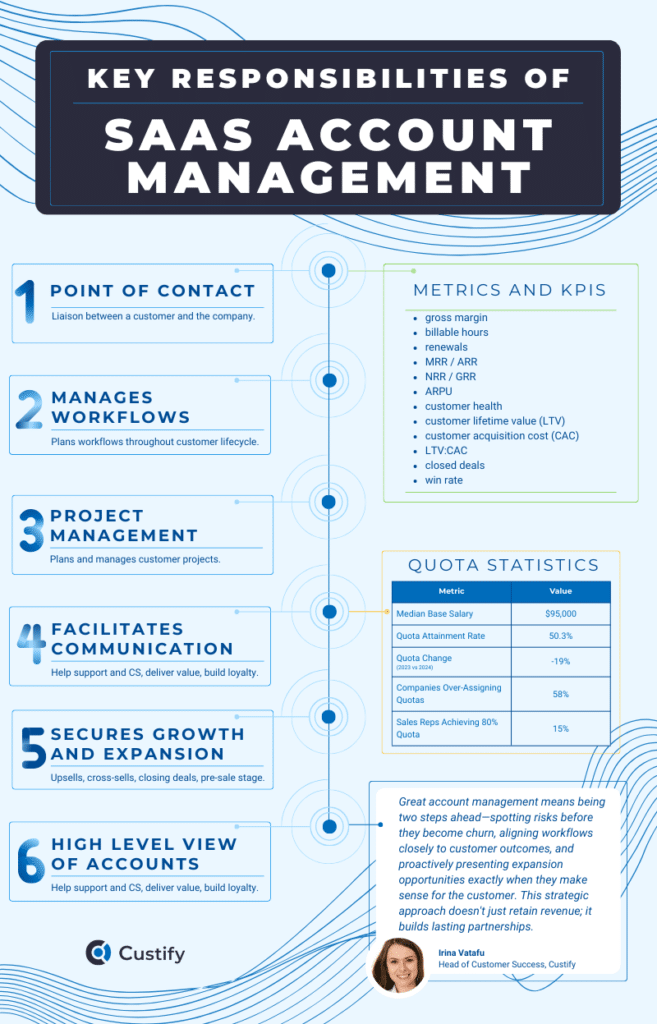
Should SaaS Account Managers have sales quotas? An opinion
As account management has evolved in recent years, so should the expectations regarding it. Recent reports showcase increased focus on sales quotas, particularly regarding upsells and retention, while just 50.3% of account managers meet those quotas. In this landscape, we need to ask: should they even have quotas to begin with?
Here’s a snapshot of where the account manager role is at today: due to fewer and fewer resources, account managers tend to be more focused on admin tasks. At the same time, the number of accounts per account manager has continued to increase. Then we have the sales quota, which most account managers I know dread, as they are expected to deliver with increasingly sparse resources and time.
If the majority of the account manager’s time is allocated to low-value work, you’ll likely find growth coming from a small number of accounts, and overall revenue growth from current accounts to be below expectations.
– Hernan Vera, Managing Partner at Sales Outcomes,
Why the Account Manager Needs a Rethink
So what’s the solution? Most of the new voices in business agree it’s time to set more realistic expectations of the account management role:
- use the 80/20 rule – set quotas so 80% of the team can realistically meet them
- assign quotas only on an account-level, reducing pressure to grow underperforming accounts
- consider account specifics – customer needs, sales resources, and, most importantly, time constraints should be part of the quota conversations
Account management needs to go back to being a true client partner – know the business like it is your own, and make them feel like they can’t live without you.
– Helena Lazar, EVP, Managing Director at King Ursa
How Account Management Is Evolving in 2025
There are positive signs, however, as overall sales quotas were 19% lower in 2024 compared to the previous year’s averages. Hopefully, we’ll continue to see more balanced expectations of account management.
How to Efficiently Handle SaaS Account Management? Best Practices
1. Understand clients and track key data points
One of the prerequisites for effective account management in SaaS is data. You need those precious numbers that tell you how a customer is doing, where they are in their customer journey, and how you can help them further along the pipeline to expansion.
This will require you to have a good tech stack setup paired with a good understanding of your customer base. Then you need to connect the dots, so to speak, and ensure all your tools communicate with one another and are able to capture valuable metrics, gather insights on customer health, and deliver them in a timely manner to your dashboard.
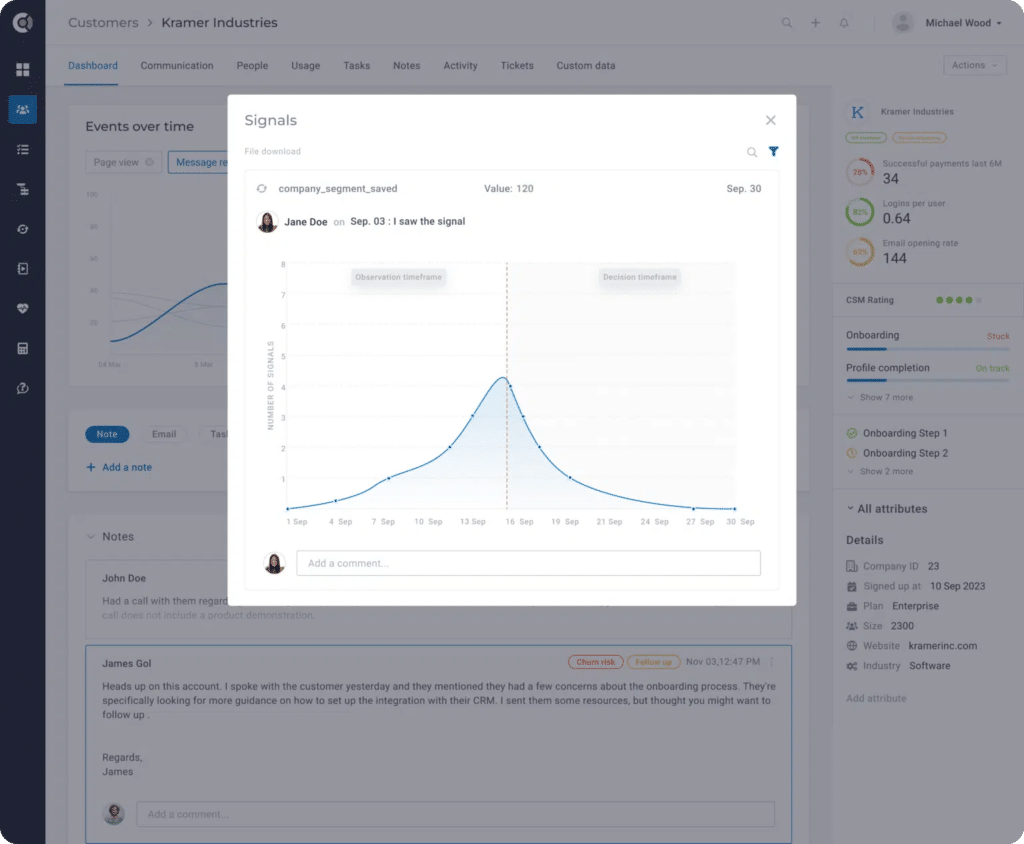
2. Have an account management strategy
A strategic approach will always yield more results and feel more coherent. Start with your pain point: do you need to increase customer retention? Do you need a higher MRR? Is your customer base churning at an alarming rate? Each of these issues can have a strategic solution based on your account metrics.
For example, for customer churn issues, I’ll always recommend first starting with a churn analysis. Then, based on the results, move on to the correct steps to fix your churn rate.
Conversely, if you’re finding it hard to upsell customers, think about what you could be doing better (based on that precious data you gathered), and come up with a better upselling strategy.
3. Map out customer segments and user personas
Customer segmentation is a classic strategy in both account management and customer success, but that doesn’t make it any less powerful. Let’s quickly recap the main steps to efficient customer segmentation:
- First, you’ll need to decide which indicators are most relevant for your user base.
- Then, ensure you’re capturing those datapoints and are able to monitor them easily and at scale (usually done by adding them to your dashboard).
- Scan your data and identify key account differences in terms of pain points, health indicators, preferred communication channels, and other specifics you land on.
- Weigh those accordingly and create segments based on customers that fit the same user profiles.
- Set up an automation that adds new customers that fit said criteria to the respective segments. However, you should also add an alert so you see when such an automation has triggered in order to verify.
Here’s an overview of the many ways to segment your user base, from our guide on SaaS customer segmentation:
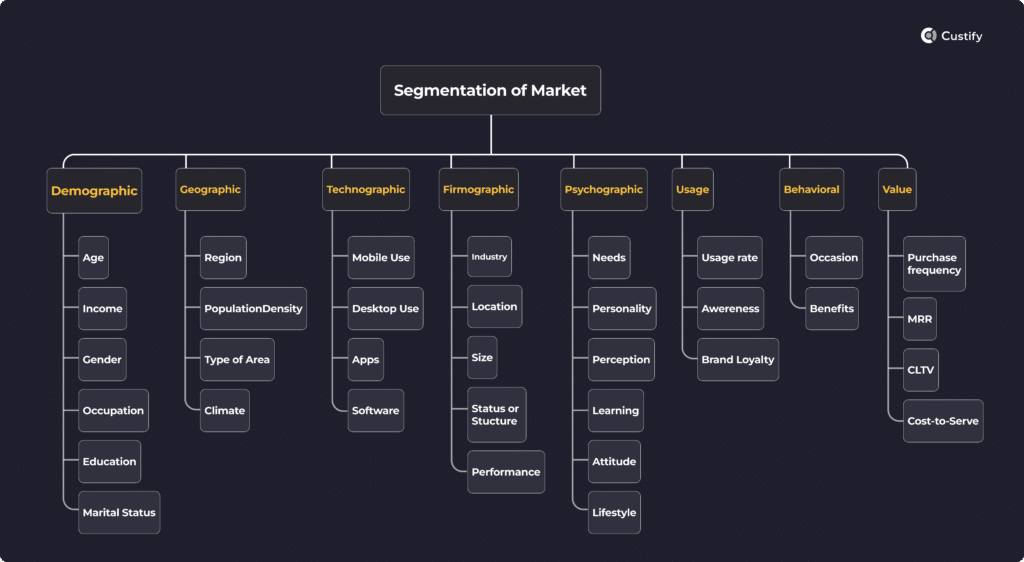
4. Onboard customers effectively
Account managers are often the first contact point customers have post-sale. Before CSMs join the conversation or take the reins, it’s the account manager who leads the conversation, sets the next steps, introduces the CSM, and lays the groundwork for efficient and purpose-driven implementation.
In order to master onboarding, you need a plan and an onboarding flow. Customers should pass seamlessly through it while you gather the most important data about them. 49.6% of onboarding managers today cite misaligned customer expectations as their biggest bottleneck. So ensure you’re capturing their goals, pain points, what value means to them, and what they expect from their relationship with your business.
Your overall customer onboarding strategy will vary depending on your engagement model, first-time user experience and how granular you want to be in customizing your customers’ experience.
For example:
- An Account Manager for a low-touch, self-service product, might set an automated onboarding flow and then monitor hundreds of accounts from their dashboard.
- On the other hand, a Strategic Account Manager with a single, very high touch account might spend months together with the CSM, engineering, and support going through onboarding, ensuring adoption, designing custom implementations, and monitoring health scores along the way.
5. Be helpful and provide value
When it comes to customer interactions, value is a subjective concept.
Think of this: you may have a flow put together for most of your customer base. Product adoption is high, you’re sending out materials to help, customers are reaching their goals. On the surface, everything’s fine, correct?
But then a new customer joins and surprise, it’s a big account, their business could help sustain your growth for years. But your traditional flow doesn’t seem to be working. They have a different use case.
That’s why you have to constantly be there in the initial pre-sale discussions. You need to sync up with customer success and tweak your value realization framework to match new customer expectations, observe current market trends, and deliver customers’ outcomes.

6. Equip your team with the right tools
Account management, particularly in SaaS, is heavily reliant on tools. Just think of the data and insights you can obtain when everything is synced up and communicates effectively across your tech stack.
To that end, you will be needing:
- A CRM tool. This will be the backbone of your day-to-day workflow. Make sure it’s intuitive and that it captures the essentials of what you need for your account management role.
- A good project management software. Seeing as account managers often deal with high level project management, you’ll need something good to complement your work.
- A powerful customer success tool. The true hidden weapon of the best account managers out there is good customer success software. The efficiencies you gain from having one will be unmatched.
- A good tool for customer feedback. Gathering and acting on customer feedback may be secondary to the account management role, but it’s nonetheless important.
- A good communication tool. Account managers spend a lot of their time talking – with customers, with other account managers, with customer success managers, C-level executives, and more. That’s why they need a communication software, such as Slack, that’s intuitive and works at scale.
- A tool for learning and development. Depending on the growth stage and budget of the organization, you may choose a different approach. It could be a full learning management system or a simply Google Drive folder full of internal training documents.
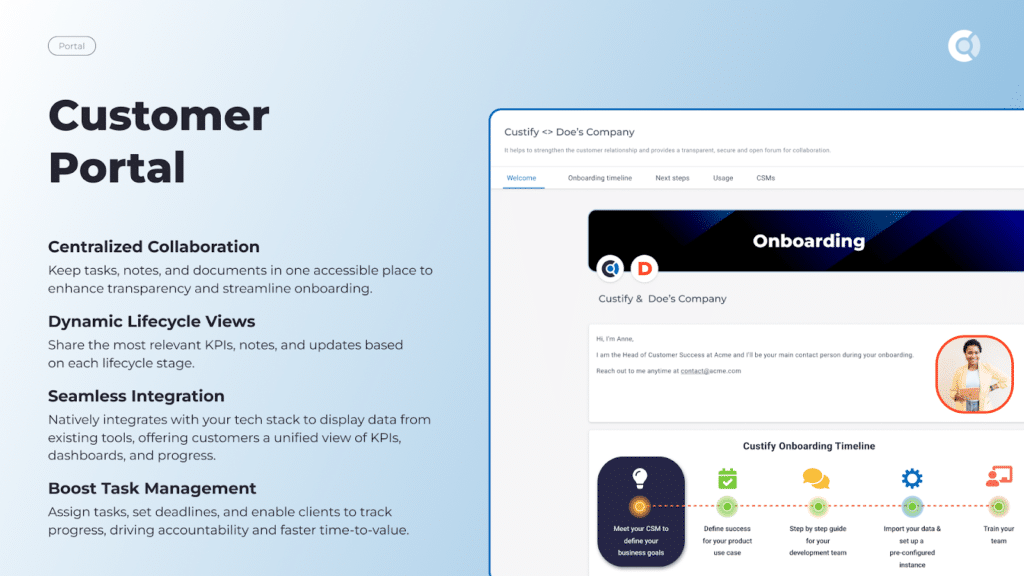
7. Monitor customer feedback and close the loops
s the control center for your customers, account management should take full advantage of customer feedback and manage its flow throughout your organization.
A customer feedback loop is the closed path of customer feedback within your organization, from asking for opinions, to receiving and collecting them, to sorting and prioritizing them, then gradually implementing them and notifying the customers who initially sent in the complaint or suggestion, essentially closing the loop.
Feedback loops are a tight-knit collaborative strategy between account management, support, customer success, and product development. A senior account manager should help ensure the teams fall into a comfortable rhythm of collecting, implementing, and communicating the feedback.
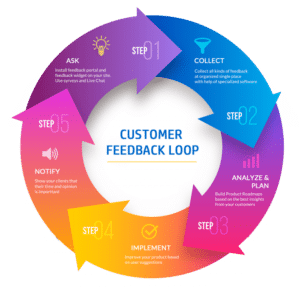
8. Work with CS to prevent churn
While not directly responsible for churn (you might’ve noticed churn rate isn’t one of the KPIs above), account management still contributes to churn reduction through almost every effort in their arsenal of tactics.
Together with customer success, account managers:
- Monitor customer health for potential signs of churn
- Increase the value customers get through upsells and cross-sells
- Help prioritize accounts to reduce the impact of any churn
- Manage key accounts to prevent revenue churn
- Offset churn through expansion of loyal accounts
9. Reward customer loyalty
A classic example of an account management tactic is customer rewards. Account management is responsible for informing customers of potential loyalty rewards.They typically work with marketing to hone the messaging and create any sales collateral to help.
Some examples of loyalty programs include:
- Referral strategy (customers receive cash, coupons, or discounts for each referral, with more rewards possible once that referred customer reaches certain usage milestones).
- Points-based rewards (awards customers points for specific actions related to product engagement, social media engagement and shares, and more).
- Expansion rewards (incentivizing upsells and cross-sells with timely rewards, encouraging customers to spend more within a certain period in order to receive them).

10. Be strategic with upsells and cross-sells
Whereas churn monitoring is more customer success’ job, expansion falls firmly within account management’s purview.
In SaaS, account managers are responsible for using the tools at their disposal to identify the best moments to propose upsells and cross-sells. Typically, this is done by identifying key value moments within the customer journey, tying those to specific actions within the product, and identifying the best place to propose upsells.
Strategic account managers, or those working with large, high-touch accounts, can also be more involved in this strategy. They can talk to customers directly when such moments show up in their journey and upsell the best offer for each specific scenario.
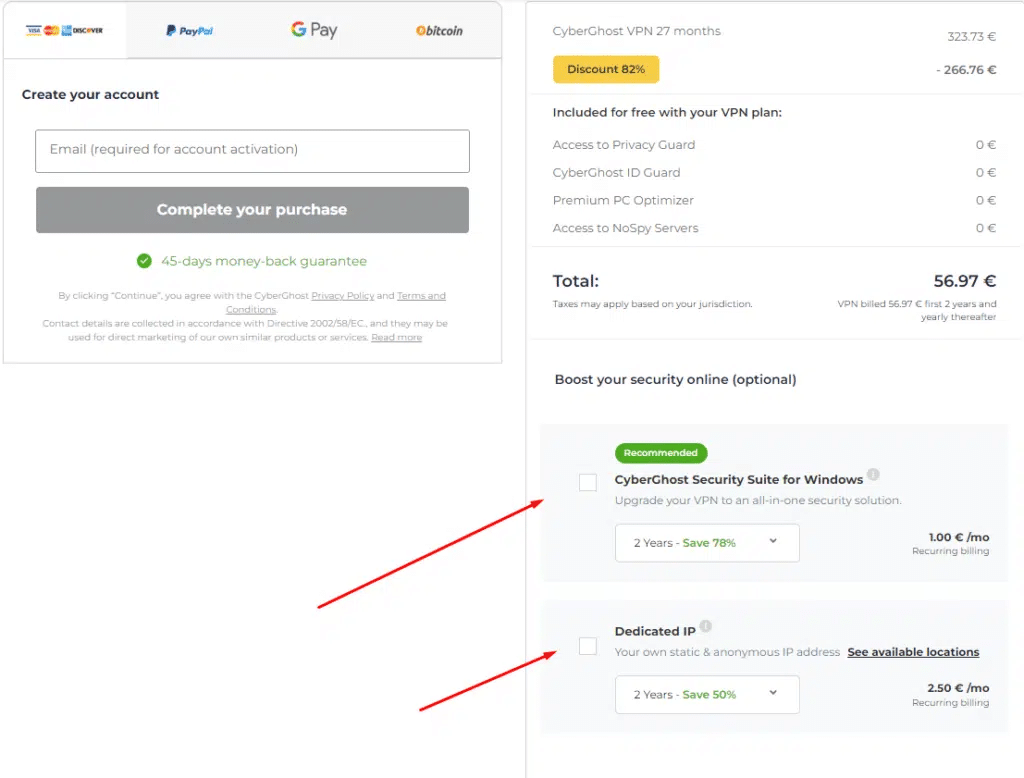
11. Assist with offboarding tactics
Regardless of how well customer success, account management, and customer support do their jobs, some customers still leave. It’s part of the SaaS lifecycle, so the more prepared you are, the better the odds that you’ll either win back the customer or learn something valuable to prevent future churn.
SaaS account managers are in the best position to decide how to approach offboarding:
- Setting up surveys to capture insights from customers on their way out.
- Holding offboarding calls to discuss why the customer is leaving.
- Putting together special offers to save accounts (such as discounts, downsells, free trials, and more).
- Writing offboarding scripts that include interview questions and win-back proposals.
Example: Referrizer saved 25% of its churned customers during the height of the 2020 pandemic through a series of offboarding tactics that included interviews, highly-specific questions, and counteroffers.
Challenges, Mistakes, and Misconceptions about SaaS Account Management
1. Challenges and Solutions
Challenge: Accounts to account managers ratio
It can be difficult to determine how many accounts are appropriate for each Account Manager in your organization.
↪ Solution:
One way to solve this is to settle on your approach: one to many, one to one, many to one, or many to many, and then customize it to your company. My article on CSM ratios has methods and solutions for rightsizing that work just as well for account managers.
Challenge: Too much reactive support
When you’re in “putting out fires” mode, it can be difficult to pull away and get some perspective. Too much reactive support will lead to you missing issues from your most important customers and potential churn from your most important revenue-drivers.
↪ Solution:
Set up your tech stack for proactive engagement – prioritize accounts, determine churn precursors and friction points, step in proactively and let customer support handle reactive requests. But keep your eye on the ball. Some issues might require you to step in.
Challenge: Cross-departmental alignment
When everyone’s working without a clear direction, it can be hard to sync up with other teams in your organization.
↪ Solution:
Work with customer success on cross-departmental alignment and collaboration. Craft or brush-up your strategy and follow it. Bring all stakeholders into the fold and ensure you’re all on the same page.
Challenge: Insufficient or error-prone data
Issues with the customer data you collect can plague your business. One bad metric can lead to a downward spiral of bad decisions. So keep a look out for insufficient or skewed data.
↪Solution:
Review your tech stack and data flow. Make sure that you prioritize the metrics you collect, ensure you are capturing them continuously and can see them in your dashboard. Last but certainly not least, follow data hygiene practices to keep everything in check.
2. Mistakes and Fixes
Mistake: Focusing on repetitive tasks
As mentioned above, when understaffed and lacking resources, account management can easily turn into a position buried by admin tasks and repetitive work that doesn’t add value.
↪ Fix:
Prioritize your tasks, work strategically, even with limited resources – find the most impactful tasks that you can handle and prioritize them. Try to obtain a bigger budget or more team members by speaking the language of the CFO – with so few resources, you can only do so much to help grow your business.
Mistake: Lacking empathy and customer-focus
Working with a sales quota can create a lot of pressure and focus on hard metrics. The natural evolution of this is a lack of customer-focus and a reduced ability to empathize with your clients.
↪ Fix:
To fix this, remember you’re working and talking with humans, not simply users, customers, or subscribers. In fact, listening and being more empathetic can actually have a positive impact on those hard metrics you’re being judged on. After all, customers want to receive value and reach their goals, and they can’t do that if you don’t understand what their problems are.
Mistake: Forgetting not everyone has the same picture of an account
When you’re surrounded by customer data and have to look at highly-customizable and optimized customer portals every day, it can be easy to think everyone in the company, or even in your team, has the same setup and can see fires burning a mile away. That’s not always the case.
↪ Fix:
Always communicate key account updates with stakeholders and share periodic reports with overviews on key accounts. Work with everyone who has access to the same subsets of data as you (customer success, customer support) and decide what to share and when.
Mistake: Not communicating with the client
A common pitfall of account work, or any customer-facing work, is to think they’re not interested in hearing from you. This could be just a natural feeling or a result of customer disengagement. But you couldn’t be further from the truth.
↪ Fix:
Remember customers will never be upset if you reach out with actual value. This could be help with something they’re working on now, it can be a guide, or it could be your next QBR. Periodic reviews, such as EBRs, QBRs, and feedback loops all help keep a steady flow of customer conversations that reassures them you’re there for them whenever they need it.
3. Misconceptions and Facts
Misconception: Account managers are just reactive CSMs
Just as CSMs can be mistaken for proactive account managers, so too can account managers be thought of as just reactive CSMs. But nothing could be further from the truth.
↪ Fact:
Account managers fill a different role within the company that is more aligned with the Sales department, and they work closely with the Customer Success department. In some cases, they might even be part of Customer Success, but their role remains distinct from that of the CSMs.
Misconception: Customers communicate when there’s an issue
You might think customers always reach out to support. This might seem particularly plausible if you’re in a company that always has a lot of open support tickets. But that’s very far from the truth.
↪ Fact:
Studies have shown that 69% of customers will attempt to fix the issue themselves (CX Trends Report), while 74% of customers will abandon a brand after three or fewer bad experiences (Connected Shoppers Report). This definitively proves that without proactive support, a large portion of your customers might abandon before they even reach out to support, or may never even bother to take that step.
Misconception: Customers are content with quarterly reviews
It’s easy to think that, just because your internal procedures say business reviews happen on a quarterly basis, your customers are fine with the schedule. But you and I both know most customers think of themselves as unicorns – they want to stand out, and if it’s an enterprise customer, they might want special care provided in exchange for how much they’re paying.
↪ Fact:
This will depend on a variety of factors such as your product, customer base, customer segments, engagement model, and many other factors. However, we generally disagree with such a blanket statement. A customer might want a check-in once every two weeks and be willing to pay for that. Others might be comfortable with reviews once every two quarters. It also depends on how many meetings you have between the periodic business reviews.
Frequently Asked Questions about SaaS Account Management
1. What skills are required for account management?
Typical account management skills include:
- Good communication and client relations skills and experience
- Customer service skills
- Client management skills
- Project management skills
- High emotional intelligence and empathy
- IT&C knowledge and capabilities
- Client analytics, monitoring, and reporting skills
- Sales and marketing knowledge
- Technical support skills
- Workflow management skills
- Onboarding and implementation assistance capabilities
2. What are account management services?
Account management services are typically those offered by third party, such as account management companies (agencies) or individual contractors (experienced account managers who sell their services to multiple parties).
3. What are account management tools?
The tools that make up the account management stack include:
- Dedicated account management platforms
- CRM platforms (such as Hubspot)
- Customer success platforms (such as Custify)
- Project management software (such as ClickUp, Asana, Trello, and others)
- Customer feedback tools (such as Zendesk, Freshdesk, and others)
- Communication tools (such as Slack, Teams, and others)
- (Optional) Learning and development tools (such as TalentLMS, Canvas LMS, and others)
4. What is key account management?
Key account management refers to the managing of customer relationships for key accounts, i.e. enterprise contracts, large business deals, or other customers that bring in a large share of the company’s revenue.
Conclusion
Properly managed accounts will always be more engaged, more willing to do business with you, and more loyal to your relationship. They tend to be both more open to you when they’re facing issues internally, as well as more forgiving and supportive when you make a mistake or are going through the same types of hardships.
This is the mission and the value of SaaS account management.
Does your account management team need more help to accomplish their goals? Try arming them with a customer success software capable of complementing their skills. At Custify, our demo calls are friendly, commitment-free chats where we try to understand your goals and help you reach them. If you decide to join, get ready for our unmatched concierge onboarding which will take you through every step of the way to implementation.




